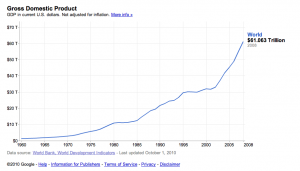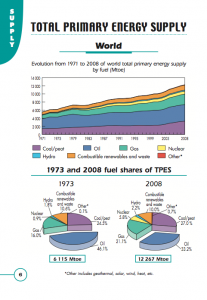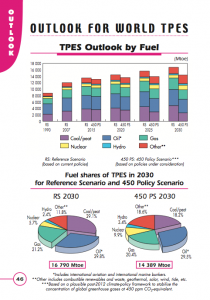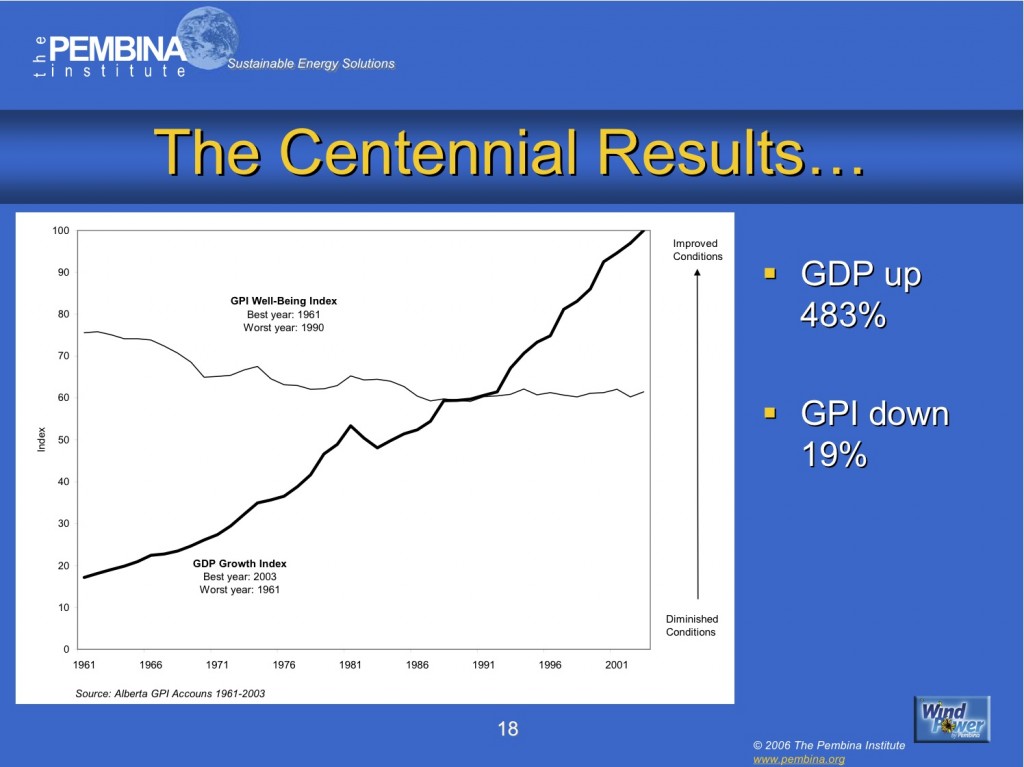Posts from — October 2010
VIFF film and interesting article
How was the film? I was too tired to make it. I just stumbled across an interesting article by Lester Brown.
http://www.earth-policy.org/images/uploads/book_files/pb4book.pdf
October 15, 2010 No Comments
Fossil Fuel and the Future of Energy Under Capitalism
I’m writing this essay partly in response to lectures by Stewart Brand and the Green Party. I’d like to speak about these lectures in relation to what we have read so far about capitalism, oil sands, arctic energy exploration and the implications for our future energy supply under a capitalist system.
Stewart Brand – Technology!
If I could summarize Stewart Brand’s lecture it would be like this: Climate change is serious and we have very little time to transition into a carbon neutral economy. The best path forward is to encourage more and faster urbanization, education and reproductive rights for women, accelerated genetic engineering of crops, bioengineering, nuclear power expansion right now with potential for fusion power to come online in the next few decades and geo engineering if necessary. In short, we need to accelerate advances in technology, economic growth and our energy infrastructure. I’ll refer back to these ideas later in reference to our readings.(1)
Green Party – Stop!
The Green Party suggested about the exact opposite stressing the Limits to Growth.(7) Their argument is that economic and population growth are the essential problems because each year our economy grows at the exponential rate of about 3% and consumes a comparative increase in material inputs like oil, water and topsoil. This consumption is an overburden to the ecosystems which support us through services like the hydrological, nutrient and carbon cycles. The only solution is to shrink our economies and population which will effect a decline in material consumption to reduce the burden on our the ecosystems.
This Limits to Growth argument rests on the premise that human activity exceeds the carrying capacity of our planet. Humans are not different than any other species which surpasses its environmental limits; If they surpass the natural limits their population will eventually crash. This should cause us concern for if our material throughput (i.e. stuff we take from the earth) and economic growth continues. In figure 1 one we see a steady exponential increase in gross domestic product (GDP), i.e. the final monetary value of combined goods and services produced, which serves as standard measure of economic growth. The graph shows a rough increase of an average of 3% increase in GDP per year. At this rate our economy will grow 3.3 times bigger over the next 40 years. In Figure 1 we see our economy was recently (2008) sitting at 61 trillion dollars. If we extrapolate that number at 3% to 2050 our economy will producing over 200 trillion dollars. The logic goes that we will also be consuming proportionally more resources, which we can’t afford to do because we already surpassed our carrying capacity decades ago. Technology is not a solution because all this new energy technology will only perpetuate business as usual economic growth, material consumption and carbon emissions. Increasing efficacy provided by technology will only decrease the intensity of material usage but not change the fact that we will still use more resources each year albeit at perhaps at a rate below 3%. The point is that it doesn’t matter how efficient our economy is if it requires more resources per unit output of GDP each year. According to this view is,the solution to stopping environmental degradation and ensuring human survival is, we don’t have a choice, we have to shrink our economies and our population by halting growth.
Mirage
My sinking feeling after hearing these lectures is that business as usual, i.e. the current formation of capitalism, and technological advance proposed by Stewart Brand is a flawed solution. It will not provide us with a solution to climate change soon enough. Not because we don’t have the technology to produce fancy new power plants, and grains, but because it will take too long and too much fossil energy to reconstruct our infrastructure for everything. New cities, buildings, vehicles, power grids and power plants will have to be rebuilt using fossil energy to transform our economy into a CO2 neutral/negative economy. Below in Figure 2 and 3 are graphs from a 2010 International Energy Agency report which shows our past and future energy supply. These graphs show that fossil fuels, oil, coal and gas have risen in use historically. Figure 3 below shows a steady increase of fossil fuel use up to 2030 with renewables making up less than half our power source at best. While certainly not set in stone, we could be emitting more carbon in the future than we are today if economic growth continues, and we have already emitted too much.
Capitalism Loves Oil
While I love the whiz bang! gadgets produced by capitalism’s wonderful capacity for innovation I feel it is not the best solution in its present form. Capitalism relies on technological change and competitive advantages in production and marketing which to date has only increasing our use on fossil energy at the very time we need to start shutting down every last fossil fuel power plant and internal combustion engine (Again see figures 2 and 3). Huber’s argument in “Energizing Historical Materialism” makes a strong case that fossil fuels are internal to the metabolism of capitalism. According to Huber, fossil energy is internal to contemporary capitalism for these reasons:
1) Fossil energy replaces human energy which decreases demand for labour and increases supply. This decreases the control of labour over the production process because there are proportionally less workers employed by each firm and by increasing the labour supply there is steady leverage against resistance because there are many more labourers to replace the resistors.
2) The ease of transportation allows concentration into cities where they can be consumed by industry and consumers.
3) Energy density and abundance have allowed increased velocities of production and time to market which in turn increases profit rates.
The problem then for any future energy source is that it will have to replicate these characteristics without a pause to sustain continued economic growth. This is then a major obstacle to stopping CO2 emissions and reducing our material consumption.
Oil Ho!
Present enthusiasm to exploit Canada’s Tar Sands and Arctic oil reserves seems natural given capitalism’s love of oil.
If we were serious about stopping CO2 emissions we would be limiting our exploitation of the Tar Sands. Yet I see no sign of a decrease in exploitation. For example Tar Sands development is a central policy of the Security and Prosperity Partnership signed by North America governments (SPP). (4) Alberta’s oil fields are the world’s largest remaining oil reserves and have attracted almost 60% of global oil investment.(4) Moreover neither Canada nor Alberta have indicated any intention to stop the total exhaustion of this resource.(4)
Similar to the Tar Sands, the Arctic is seeing vigorous investment by energy companies and energy states such as Russia. The Russians are betting on Arctic energy to fuel their future economic growth and imperial ambitions. They planted a flag beneath the North Pole on the sea bed hoping to prove that the sea floor is an extension of the Russian landmass so they can explore fossil energy deposits.(5) The Russian state owned enterprise (SOE), Gazprom, is the largest gas extractor in the world. Russia now ranks third behind Iran and Saudi Arabia for the oil and gas reserves. This would support the evidence offered by the IEA energy forecast that fossil energy is not going away anytime soon.(5)
Sounds kind of grim really. I think realistically the solutions to reduce human impacts on the earth lies somewhere in between Stewart Brand’s and ‘Limits to Growth’ arguments; We need some technological innovation and we need to seriously consider halting economic growth, at least in the developed world. Of course things may turn out quite differently than any of us can imagine. However, I don’t think that mainstream political and business leaders or society for that matter are being intellectually honest or listening to the predictions of the consequences of a business as usual future. I know there is debate over how many people the earth can support, but it would be prudent to guess on the conservative side. It’s easier to grow later than be forced to shrink after it’s too late. The friction to change our behavior is only natural because any serious reduction in energy consumption of the system is likely to the power of elites and sacrifice the high quality of life we in the developed world feel entitled to. However things may turn out, it remains to be seen how tolerant the earth’s biosphere and atmosphere are to the endless growth ideology that is capitalism and its insatiable appetite for fossil fuel.
Bibliography
(1) The ideas of Stewart Brand can be found in his new book: Whole Earth Discipline: an ecopragmatist manifesto (London: Atlantic Books, 2010)
(2) www.google.com, “global gdp”.
(3) Huber, T. “Energizing historical materialism: Fossil fuels, space and the capitalist mode of production.” Geoforum 40, (2008): 105-115
(4) Nikiforuk, Andrew. Tar Sands: Dirty Oil and the Future of a Continent (2008). p. 2
(5) Sheppard, Lola and White, Mason. “Meltdown: Thawing Geographies in the Arctic”. pp. 133-134
(6) International Energy Agency, “Key World Energy Statistics 2010”. http://www.iea.org/.
(7) Meadows, Donella. The Limits to Growth. New York: Universe Books, 1972.
October 15, 2010 1 Comment
"Meltdown: Thawing Geographies in the Arctic" – Critical Response 1. by Allison Franko
In their article, architects Lola Sheppard and Mason White offer a provocative, yet somewhat romantic and opportunistic, vision of a current and future ‘urban arctic’. They claim that, due to current and growing world demand, the arctic oil and gas reserves will be further explored and exploited, fueling an ‘emergent frontier urbanism’ in the arctic (pg. 133). Aided by the thawing of the ice cap, paradoxically hastened through man’s use of fossil fuels and resultant effects on climate change, increased arctic resource extraction will lead to new and expanded urbanization. Although I do not find that the authors are actually endorsing the development of the Arctic, their article nonetheless tends to glorify the process and its infrastructural icons. In this response, I aim to highlight the authors’ rose-tinted viewpoint on Arctic resource exploitation, infrastructure, and suggested urbanization.
As the authors are both architects, I feel they fail to give proper consideration to the expansive realm of human and environmental geography; as such, current and future resource extraction in the arctic, by any political or corporate entity, is depicted as desirable for the barbaric Arctic region, or ‘the other’. The authors postulate that the thawing of the Arctic is in part facilitating emerging urban cities reminiscent of unbuilt “megaform” projects of the 1960s and 1970s” (pg. 136). This comparison is indicative of the authors’ admiration for urban development of the Arctic, regardless of what environmentally-distressing technologies and infrastructures are inevitably deployed.
Moreover, the authors’ reliance on key premises without evidentiary support and the occasional use of certain jargon (such as, ‘virgin geography as a zero condition’ and ‘techno-geographical utopia’), bad examples, and confusing analogies, sometimes detracts from the article (pg. 136). I disagree with their proposition that the melting of polar ice has “simultaneously spawned territorial land claims” (pg. 133). The melting of ice may have indeed sped up exploration, threatened ecosystems, or otherwise contributed to various changes, but the expression ‘simultaneously spawned’ inappropriately implies suddenness, as well as inaccurately attributes a cause-and-effect relationship.
In their discussion of subterranean land claims in the arctic, the authors’ claim, that the entire Arctic Circle is a contested space, is clearly false; much of Canada, Russia, and the other noted countries have completely uncontested land rights at or above the Arctic Circle. Notwithstanding this, they correctly point out certain countries are indeed making territorial land claims, particularly Russia, to the various arctic sea floors and the resources beneath. As well, the authors’ implication that several countries’ race for these claims has “led to a series of inevitably networked cities bound by ambition to serve as a hub for development of [the Arctic] region”, is weak because the premise of inevitability is unsupported and the infrastructural cities’ ambition, if personification is acceptable, may be shared, but it cannot be binding (pg. 133-134).
We can see the issue of scale arise when the authors discuss the ‘gaseous state’ of the infrastructural city, characterizing ‘gas urbanism’ in the Arctic (pg. 134). The statement that such cities are “without definite shape and of relatively low density,” contradicts their thesis of an increasing urban population in the Arctic (pg. 134). Furthermore, the image on the last page of the article (pg 137), of a floating platform housing more than 150 workers, illustrates the fact that these workers are not there to live, they are there to make a profit. The inhabitants of these infrastructural cities in the Arctic are almost exclusively employees and only live in such places because twenty four-seven production is demanded by their corporate employers- not because they see it as a ‘techno-geographical utopia’ (pg. 136). Most people would not choose to live in such an inhospitable environment without serious incentives and compensation. Unfortunately, certain readers of this article will be largely unaware of the heavy environmental, political, and social consequences specific to resource extraction in the Arctic; as a result, some may take the article at face value. In view of this, perhaps the theme of urbanization being forced upon the Arctic, in pursuit of the profits associated with resource extraction, would have been a more appropriate choice for these authors, particularly in view of current worldwide concern for climate change and its consequences.
Works Cited:
Sheppard, L., and White, M. (2009). Meltdown: Thawing Geographies in the Arctic. In Ramos, S., and Turan, N (Eds.), New Geographies: After Zero (pg. 132-137). Hong Kong, China: Regal Printing.
October 15, 2010 No Comments
Alison Smith Critical Response 1: GDP vs. GPI
Basing countries over all well-being or success solely on GDP is neither an accurate nor a constructive means of measure. As thoroughly explored by James O’Connor, Marx had acknowledged the ignored variables that fuel capitalism and dubbed them production conditions. Our class is acutely aware that GDP is a poor measure when assessing economic, social and environmental welfare simultaneously. Therefore it would be beneficial to examine the GPI (Genuine Progress Indicator) as a replacement for the GDP.
O’Connor states, “We need a more refined theoretical approach to the problem of…land and labor,” and in 1995 three economists, Herman Daly, John Cobb and Philip Lawn asserted that the accounting for the GDP was fundamentally misguided and introduced the foundations of the GPI. The major distinction between the two metrics is the categorization of a ‘cost’ and a ‘benefit.’ The GDP measures all production, but does not account for what is required and or demolished for the production. For example, the GDP includes crime as a benefit because the monetary exchange that accompanies property repair, legal fees or medical bills add to the accumulation of wealth and increases the GDP. Additional examples of how social or environmental crisis are valued to the budget of the GDP are natural disasters such as hurricanes or corporate neglect such as oil spills. The destruction of Hurricane Andrew in 1992 actually increased Southern Florida’s GDP due to development repair and rescue funds. Not only does the GDP mask the break down of social structures and natural habitats and resources, it actually portrays such breakdowns as economic gain.
The majority of North Americans have a misconception about the GDP embedded in their brains. The associations of growth and individual wealth are synonymous with the exponential trend of the GDP (the increasing gradient in the graph.) The concept of what O’Connor calls ‘limits to growth’ is a dominant force in why politicians, economists and citizens alike are not quickly encouraging the use of the GPI. It is apparent that the GPI lacks the ease of calculability of that of the GDP. It is very hard to measure the effects of economic growth such as resource depletion, ecological harm, social destruction and inequalities in a concise tangible denomination. For this reason the GPI for Alberta (created and researched by the Pembina Institute) is expressed in a monetary value, however the parameters of its calculations include 51 indicators of well-being. Where GDP is only 1 of the 51 indicators. The gap between the rich and poor, house hold debt, problem gamblers, obesity, timber sustainability and volunteerism are just a few indicators that contribute to a more balanced and accurate account of societies progress. It is interesting to note that as Alberta’s GPI is leveling out the GDP is continually rises, at the expense of economic, social and environmental conditions.
As much as I personally believe the GPI is a superior metric I still have doubts about how these indicators are actually measured and I am also slightly skeptical of who establishes these parameters of measurement. The information The Pembina Institute offers is exceptionally thorough, and allows access to the methodologies and results to all 51 indicators. However, each indicator is indexed to the GPI standard by different approaches and this makes the metric an extremely complex and dynamic system. The GPI is far more difficult to fully comprehend than all the aspects of the GDP and takes a great deal of time and research to get it initiated. I hope this system continues to expand in popularity because it is a step in the right direction of real accountability of economic expansion.
Graphs and Table source:
Taylor, Amy. “Measuring Progress in Alberta: The GPI.” March 2006. The Pembina Institute: Sustainable Energy Solution. 10 October 2010 <http://www.pembina.org/economics/gpi/alberta>.
October 14, 2010 No Comments
Another interesting article re. efficiency
http://www.fastcompany.com/1583947/peak-oil-new-urbanism-biofuels-solazyme
October 13, 2010 No Comments
Is Sustainable Capitalism Possible? A Critical Response.
Any discussion of sustainable development is in itself problematic, as it suggests developing or improving upon something that is constant or unchanging. If this logic is used to critically evaluate sustainable capitalism, then it too is a flawed concept. This paper stands to illustrate the problems associated with the concept of sustainable capitalism and review potential steps that will allow a transition from carbon dependency to a system based on clean energy.
“While there are many variations of economic growth theory, all presuppose that capitalism cannot stand still; that the system must expand or contract, in other words, that it is both crisis-ridden and crisis-dependant…” (O’Connor 1998: 240). This statement brings up the first and second contradictions to capitalism; the first contradiction states that when capital tries to increase profits by reducing costs at the expense of the labour force, (i.e. mechanization/automation, or wage reductions); it inadvertently causes a reduction in consumer demand, a demand-side crisis. The second contradiction of capitalism states that “capital limits itself by impairing its own social and environmental conditions, hence increasing the costs and expenses of capital…” (O’Connor 1998: 159). This contradiction assumes that individual capitals offset the economic costs of increased production onto society and the environment, which evades the short-term costs but increases the negative long-term effects. With this reasoning it’s plausible to state that for capitalism to be sustainable it must commoditize its own barriers; that is, it must create a market for alternative energy, environmental cleanup and monitoring, occupational health and safety, and so on, so that these elements become part of, rather than against the capitalist system.
Carbon offsetting has created such a step, wherein it promotes carbon reduction by penalising activities/procedures that are carbon intensive. The income generated from this method would “allow industrialized countries to meet their [Kyoto] emission reduction targets by purchasing emission reductions that are associated with projects in the developing world…or eastern European economies in transition.” (Bumpus 2008: 128). While this step works to help solve the problem, it alone is far from the answer. Over time many problems have arisen from carbon offsetting, which is to be expected as this method should be viewed as a step in the right direction rather than the solution to the overall problem. Carbon taxation is another step to reduce carbon dependence, in which indirect taxes are implemented on fossil fuel inputs such as coal and oil, and outputs like gasoline and propane, in proportion to their carbon content. Within Canada, this model works similar to carbon offsetting in that it provides incentives to reduce carbon usage, but it does so in a rather direct manner that is easier for users to calculate. This model reallocates the tax revenue to fund carbon reduction techniques, but the income generated remains within each province, rather than going to developing nations. While carbon offsetting and taxation help provide incentives to reduce carbon dependence and provide global funding for a sustainable energy system, they do not provide the solution. These carbon incentives have been introduced to many nations and corporations, but are not well monitored or enforced. As such, there is a need to create a governing body or bodies to oversee progress and further develop the system.
This calls upon individual governments to develop “national expenditure policies that heavily subsidize alternative energy sources; technological research that leads to eliminating toxic chemicals and other substances at the source; innovations in mass transit; occupational health and safety conditions; national, regional and community enforcement procedures; and a redefinition and reorientation of scientific and technological priorities generally.” (O’Connor 1998: 237). This action will be met with resistance from both industry and society as it removes some elements of free will and imposes requirements on both. Government involvement, however, plays a key role in redefining our use of energy and has the ability to improve the development of sustainable capitalism and reduce the timeframe, through subsidies and enforcement. In this situation, involvement needs to be brought in methodically to minimize the short-term losses of profit, and it should be done in a way that encourages cooperation rather than enforcing it. This can begin with methods like carbon taxing, which will help subsidize the infrastructure mentioned above. Involvement by a governing body is necessary, as the task is too large to assume individuals will effectively take it upon themselves to organize and commit to a plan in which short-term profits are reduced, for a hope of long-term gains that may not be realized in their generation. For this reason, a global shift in the way individuals consume their resources must also accompany the change.
For too long developed nations, especially continental North America, have had seemingly unlimited access to cheap energy and this has fostered nations driven by overconsumption. The capitalist modality of wealth accrual and profit maximization has created and egocentric outlook, which places little emphasis on externalities created during the process. Developed societies need to move from a consumption-dominated behaviour to that of conservation. The availability of cheap energy has also allowed the development of steadily rising wages, and so as the cost of energy increases, there will likely be an effort on the part of capital to cheapen labour, which again brings up the first contradiction to capitalism (Abramsky 2010). Therefore these proposed solutions involve increasing the cost of energy and activities that use energy through direct and indirect taxes, while decreasing the cost of labour and parts of the labour force. On the other hand there will be new markets created for economic opportunities, but it will be important to regulate these markets so that the wealth is shared among the people, not only going to the hands of a few large corporations or nations.
Society needs to find a way to subsidize or finance a transition to cleaner energy sources that won’t induce a crisis in the economic system. We need to find a way to effectively switch from readily available, cheap energy, and move to an energy system that promotes a conservative outlook at energy usage through deterrents and incentives. For the above reasons it is especially critical that this shift is received by both industry and society, as this is an issue that cannot be fixed quickly, but must be brought into global culture and created as a social norm.
Literature Cited:
1. O’Connor, James. 1998. Natural Causes. Guilford Press. London
2. Bumpus, Adam., Liverman, Diana. 2008. Accumulation by Decarbonisation and the Governance of Carbon Offsets. Economic Geography. Volume 84, Issue 2, pages 127-155.
3. Abramsky, Kolya. 2010. Sparking a Worldwide Energy Revolution. AK Press
October 12, 2010 1 Comment
The Crisis of the Fossil-Fuel Mode of Production: Critical Response1
The system of global capitalism is approaching limits to growth. Most clearly poised for transformation is the underlying energetic basis of the economic system, fossil fuels. In this response I will briefly historicize the integral nature of fossil fuels to the contemporary form of capitalism and seek to understand the ways in which capitalism is coping with limits to its energetic basis.
Historically, fossil fuels played a critical role in the spread of capitalist relations. Fossil fuels, particularly oil, are an extremely concentrated source of energy and a geographically mobile source of energy. These flexible properties forever changed capitalism’s productive forces, and its means of circulating (transporting) commodities. Matthew Huber notes that prior to the industrial revolution, roughly 85% of all mechanical energy came from animal and human muscle power, the rest coming from wind and water (107). The industrial revolution freed production from numerous physical (land/bodies) and temporal constraints. The intensity with which fossil fuels could be used did not change through the progression of the day, or the passing of the seasons. Steamboats, railcars and later, automobiles, circumvented the barriers to markets that long-distance travel represented, thereby increasing the sphere of commodity relations to a world scale. For the first time ever, the core energetic base of the production process was no longer human power, but rather an inanimate resource Gavin Bridge termed “geological subsidies to the present day, a transfer of geological space and time that has underpinned the compression of time and space in modernity” (48). The social relationship to capitalism also transformed; workers become more and more like a “living appendage of the machine” (Huber, 109).

Since the Industrial revolution, inexpensive fossil fuels have been normalized and internalized as necessary conditions for production and circulation. The spatial conditions necessary to sustain such a system are so prevalent (cars, trucks, highways, airports ect.) as to become nearly invisible and largely taken-for-granted. The vast claims on spaces made by this infrastructure are critical to globalization and the most successful and important logistical innovation for industry today, “Just-In-Time Production”. This mode of production fully harnesses the logic of cheap, space-annihilating transport for the following reasons: “very low coast of transport as a proportion of total costs; and the very large savings that can be made by manufacturers who use long-distance sourcing and inter-plant transfers to benefit from wage rate differentials, economies of scale, and variations in grants and subsidies to manufacturers who claim, and appear, to be creating jobs by moving them around” (Whitelegg, 67).

However, this historically specific “fossil-fuel mode of production” is poised for a dramatic upheaval in the face of peak-oil. While many speak of a looming energy-crisis in terms of a collapse or confrontation with “scarcity”, it could be reasonably argued that capitalism is experiencing the “energy crisis” in an all together different way. As James O’Conner notes, “Limits to growth … do not appear, in the first instance, as absolute shortages of labor-power, raw materials, clean water and air, and urban space, and the like, but as high-cost labor-power, resources, and infrastructure and space” (1998, 243). As the easy-to-recover oil reserves become few and far between, oil companies are exploring ways to overcome the expensive limitations to profit that deep-sea oil, Arctic oil, and tar sands reserves represent. In this sense, the peak-oil crisis is not about running out of absolute reserves of oil, but instead is a confrontation with the loss of the massive subsidy that cheap oil represents and the falling rate of profit this entails. The traditional neoclassical economic model assumes that growth is only constrained by demand (O’Conner, 1998, 243). However, when the costs of labor, nature, infrastructure and space increase, capitalism must restructure or experience crisis. To avoid crisis, the oil industry’s strategy has been twofold; (1) rely on technology development to make uncooperative oil reserves like the tar sands profitable, and (2) build infrastructure such as pipelines thousands of kilometers long to overcome the costs that vast distances represent. I think this imperative to overcome the limitations to profit is highly relevant to understanding some of the largest energy and construction projects in recent times. Both the Alaskan Oil-Pipeline and the current Tar-Sands projects in Alberta (along with the Enbridge proposal to pipeline oil across BC to China) represent the immense political and economic drive to overcome limits to growth, no matter what the spatial or thermodynamic implications.
The PBS documentary The Alaska Oil Pipeline vividly showed how the oil crisis of 1973 rationalized this controversial mega-project. After the OPEC embargo, US President Nixon signed the Trans Alaska Pipeline Authorization Act into law, disabling any further legal challenges to the project. The pipeline project mobilized near-instant work camps in the isolated Arctic terrain to work day and night on an “eight hundred mile pipeline that traversed three mountain ranges, thirty-four rivers, and eight hundred streams” (PBS). By the end of the project, 32 pipeline workers had lost their lives, and the ecosystems of Prince William Sound are still recovering from the 1989 Valdez tanker spill (PBS).
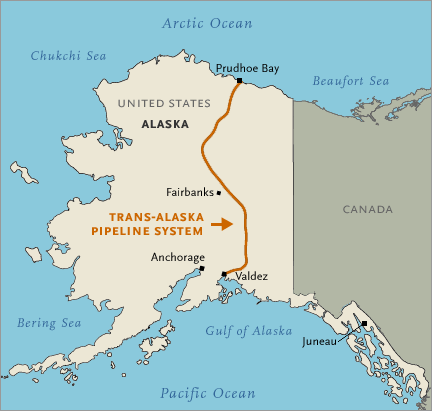
The higher the price of oil, the more incentive oil companies have to develop uncooperative reserves. However, because price is an abstracted value, or a claim-on-wealth, it cannot currently account for the thermodynamic limitations that energy-intensive resources entail. The issue of whether oil can be turned a profit is entirely mute when the amount of energy used to extract and refine oil approaches the amount of energy you recover. A true-cost accounting of the Albertan Tar-Sands project would revise the notion of profit as a clever shifting of costs onto the environment and future generations dealing with climate-change. So long as the benefactors of the traditional energy-sector hold political sway, industry will continue to rationalize its ever-expanding need for the “black gold”.
Works Cited:
- Gavin Bridge – “The Hole World: Scales and Spaces of Extraction” in New Geographies 2009, (vol 2). Harvard University Press
- James O’Conner – “Is Sustainable Capitalism Possible?” in Natural Causes (1998), Guilford Press, London
- Matthew Huber – “Energizing Historical Materialism: Fossil Fuels, Space and the Capitalist Mode of Production” Geoforum 2009 (Vol 40), Issue 1, Pg 105-115,
- John Whitelegg – Critical Mass: Transportation, Environment and Society in the Twenty-first Century (1997), Pluto Press, London.
October 9, 2010 No Comments
"Gasland" Explores Natural Gas Drilling in the US and Groundwater Contamination
Will the boom in natural gas drilling contaminate America’s water supply? NOW on PBS explores the issue. You can watch the 30-minute episode on the NOW website here.
NOW talks with filmmaker Josh Fox about Gasland, his Sundance award-winning documentary on the surprising consequences of natural gas drilling. Fox’s film—inspired when the gas company came to his hometown—alleges chronic illness, animal-killing toxic waste, disastrous explosions, and regulatory missteps.
And here is the trailer for the actual film Gasland. I don’t think it’s out on DVD yet.
-Andy
October 8, 2010 No Comments
Myth of a techno fix?
Here’s a link to Jevon’s Paradox. Anyone from economics studied this? Seems like a sobering perspective on the so called technological fix to reducing our consumption or rate of consumption of material resources.
http://en.wikipedia.org/wiki/Jevon%27s_paradox
October 8, 2010 1 Comment
Eco Socialism
Article links accessible via ubc vpn or on campus internet connection:
Prospects for Eco-Socialism S Sarkar 2010
http://www.springerlink.com/content/p05241ug60x186k1/
On Conptempary Eco-Socialism, D. Pepper 2010
http://www.springerlink.com/content/kq4552u360117n69/
October 6, 2010 1 Comment
